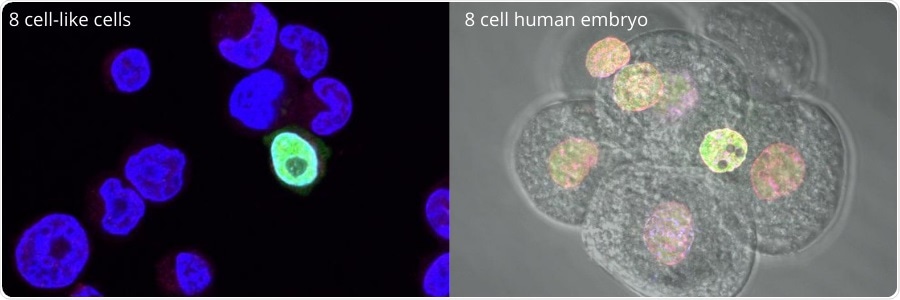Reik lab researchers’ recent discovery describes a new subpopulation of human embryonic stem cells that closely match the cells present at the genomic “wake up call” of the 8-cell embryo stage in humans.

Image Credit: Babraham Institute.
Researchers will be able to map out critical genomic changes throughout early development using this novel stem cell model, which will aid in a deeper understanding of the significance of genome activation faults in developmental abnormalities and embryo loss.
The early embryo in all mammals goes through a series of molecular events shortly after fertilization that set the scene for the rest of development. The embryo’s genome takes over regulation of the cell’s activities from the maternal genome during this crucial “wake up call.” This occurs in humans during the 8-cell stage and is referred to as zygotic genome activation (ZGA).
Before the result of this research, scientists could only investigate the details of human ZGA in human embryos. Current human stem cell models only portrayed the embryo at later stages of development. Investigations on embryos are permissible but strictly restricted in the United Kingdom—therefore research into early development has mostly relied on non-human animals.
In 2012, researchers discovered cells in mouse embryonic stem cells (ESCs) that represented the genome activation stage of development, allowing them to learn more about mammalian ZGA. The Reik lab has now discovered a human equivalent, over a decade later. The breakthrough made by the Reik lab paves the path for everyone to learn more about the early stages of preimplantation development.
Studying mouse embryonic stem cells has allowed researchers to learn about the general process of genome activation, but we could learn even more about this important step in human development thanks to our discovery of a human stem cell counterpart.”
Dr Jasmin Taubenschmid-Stowers, Study Lead Author and Research Fellow, Reik Lab, Babraham Institute
Cells take copies of the genome in the form of an RNA code, which is then translated into proteins, to operate. The RNA code output is known as the transcriptome and it can be used to pinpoint various cell populations.
In the current research, scientists utilized existing human data sets and information from mouse ESC studies to pinpoint characteristic transcriptome marks that can be linked to genome activation. With the help of single cell techniques, the researchers started the search for similar cells in their population of human ESCs.
The researchers discovered that a subpopulation of human ESCs with the proper transcriptome characteristics could be a good match for the 8-cell stage, which is when the major wave of genome activation happens. They termed these cells “8-cell like cells,” or 8CLCs, and used previously published human data to establish that they exhibited the same molecular outputs suggestive of genome activation and could be used as a trustworthy model for future research.
Professor Jennifer Nichols of the Wellcome–MRC Cambridge Stem Cell Institute collaborated with the researchers to further investigate the parallels between the 8CLCs and the 8-cell stage in human embryos. They were able to identify and seek proteins that were suggestive of ZGA in both groups of cells by working together. Their findings revealed that the ZGA-associated proteins found in 8CLCs were very similar to those found in human 8-cell embryos.
The collaboration with Dr Nichols and her team was vital as we could identify selected proteins and really look at those in real, fixed human 8-cell stage embryo cells compared to our new stem cell counterparts. This work confirmed that our 8C-like cells matched at the protein level too, in additional to the transcriptomics data, providing validation that the 8-cell like cells matched embryo cells across multiple molecular layers.”
Dr Jasmin Taubenschmid-Stowers, Study Lead Author and Research Fellow, Reik Lab, Babraham Institute
“Our focus is now to characterize these cells and understand their unique properties so that we can use 8-cell like cells as a tool to ask questions about the molecular changes that may cause developmental issues at this early stage,” said Professor Reik, Babraham Institute group leader.
Source:
Journal reference:
Taubenschmid-Stowers, J., et al. (2022) 8C-like cells capture the human zygotic genome activation program in vitro. Cell Stem Cell. doi.org/10.1016/j.stem.2022.01.014.